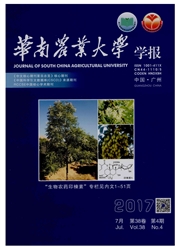

 中文摘要:
中文摘要:
[目的]本研究旨在探明稗草和水稻叶片表面蜡质的化学组成对尖角突脐孢菌在侵染其植株中附着胞形成的不同影响及原因。[方法]以3~4叶期的稗草及水稻叶片为试验材料,采用氯仿提取和去除叶片表面层蜡质及人工制备叶表层蜡质膜等方法,研究不同蜡质表层病原真菌分生孢子萌发及附着胞形成情况,并采用气相色谱/质谱(GC-MS)法计算及分析其叶片表面蜡质组成及含量。[结果]去蜡稗草叶片上尖角突脐孢菌附着胞形成率显著降低,去蜡水稻叶片附着胞形成率显著增加;稗草叶片表面蜡质膜对病原真菌附着胞形成有显著促进作用,水稻叶片表面蜡膜相对于玻璃表面对真菌附着胞形成无显著影响。稗草及水稻叶片表面蜡质晶体结构及成分分析结果表明:稗草和水稻叶片表面蜡质中各组成成分相似,均检测到脂肪酸、初级醇、醛及烷烃类物质,但其相对含量差异显著。稗草叶片表面蜡质组分中烷烃类占总含量的29.99%,极显著高于水稻(20.05%),而水稻中醛类的相对含量为22.72%,极显著高于稗草(15.17%)。叶片表面蜡质中不同长度的碳链化合物相对含量不同,稗草叶片表面蜡质中主要碳链化合物为:C32醇18.87%,C18醛14.61%,C33烷烃14.83%;水稻叶片表面蜡质中主要碳链化合物为:C30醇32.71%,C18醛21.58%。稗草叶片表面蜡质组成中没有检测到C24醇以及C24醛类物质,而水稻叶片表面蜡质组成中没有检测到C35烷烃。[结论]稗草叶片表面蜡质对尖角突脐孢菌附着胞形成有促进作用,水稻叶片表面蜡质对该菌附着胞形成存在抑制作用,稗草和水稻叶片表面蜡质中烷烃类及醛类化合物的相对含量差异极显著,其中C30醇、C32醇及C33烷烃的相对含量差异较大。
 英文摘要:
英文摘要:
[Objectives]The study aims to find out the effects of appressorium formation of Exserohilum monoceras on epicuticular wax from Echinochloa crus-galli( host) and Oryza sativa( non-host),and further lay the foundation for reveal the mechanism of appressorium formation. [Methods]3-4 leaves stage of barnyardgrass and rice leaf at best infection stage for E. monoceras were used as experiment material in this study. A method of simply evaporating chloroform was used to remove and extract the epicuticular wax on barnyardgrass and rice leaf for inducing the appressoria formation at different surfaces. And then gas chromatography-mass spectrometry( GC-MS) was used to calculate and analyze the composition and content of wax. [Results]The results showed that appressorium formation of E. monoceras on leaf removed of epicuticular wax was significantly lower than intact leaf of barnyardgrass. The barnyardgrass leaf removed and not removed epicuticular wax all significantly higher than rice. And appressorium formation on the artificial surface covered with barnyardgrass epicuticular wax was significantly higher than that covered with no wax and rice epicuticular wax. Analysis using GC-MS indicated that the constituents of these two epicuticular waxes were remarkably similar but content was different,and fatty acids,primary alcohols,aldehydes and alkanes were isolated and identified from the extraction wax of barnyardgrass and rice. The percentage of alkanes of barnyardgrass epicuticular wax 29. 99% was extremely significantly higher than the rice wax 20. 05%,and aldehydes of rice wax 22.72% was extremely significantly higher than the barnyardgrass wax 15.17%. There were obvious differences between the content of different compounds with different carbon chain length in the epicuticular wax of barnyardgrass and rice. The percent contents of main constituents of barnyardgrass epicuticular wax were 18.87% C32 alcohol,14.61% C18 aldehyde and 14.83%C33 alkane. The percent contents of main constituents of rice epicuticula
 同期刊论文项目
同期刊论文项目
 同项目期刊论文
同项目期刊论文
 期刊信息
期刊信息
